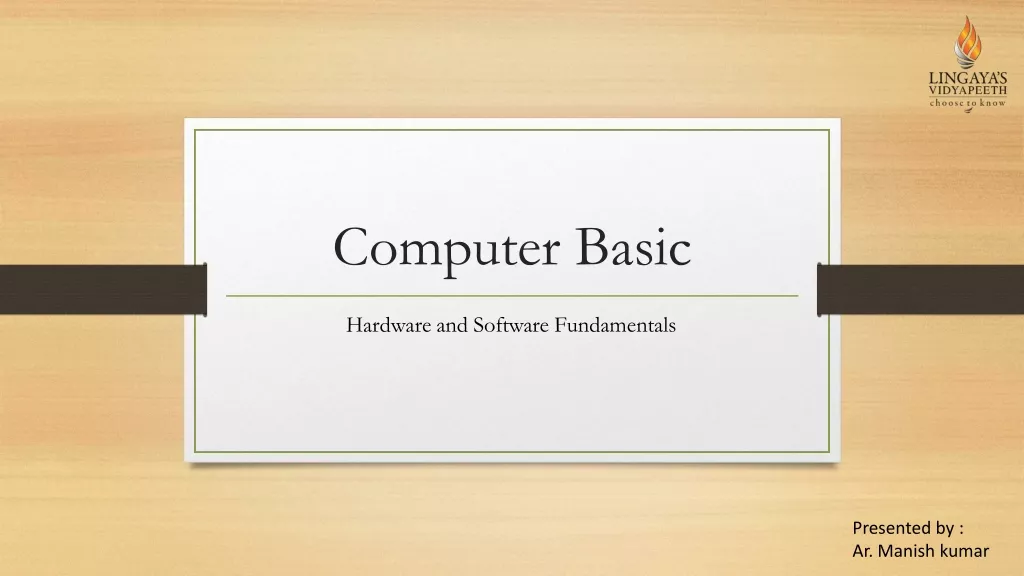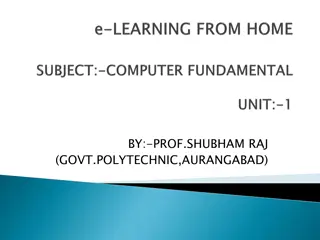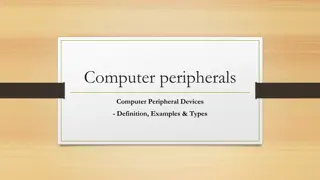Overview of Input Devices in a Computer System
Input devices are essential hardware components that allow users to interact with computers by sending data for processing, display, storage, or transmission. Examples include keyboards, mice, barcode scanners, and more. These devices provide advantages such as speeding up data collection, reducing errors, and facilitating data consolidation.
Download Presentation

Please find below an Image/Link to download the presentation.
The content on the website is provided AS IS for your information and personal use only. It may not be sold, licensed, or shared on other websites without obtaining consent from the author.If you encounter any issues during the download, it is possible that the publisher has removed the file from their server.
You are allowed to download the files provided on this website for personal or commercial use, subject to the condition that they are used lawfully. All files are the property of their respective owners.
The content on the website is provided AS IS for your information and personal use only. It may not be sold, licensed, or shared on other websites without obtaining consent from the author.
E N D
Presentation Transcript
Input and Output devices in a Computer
Input Devices An input device is a hardware or peripheral device used to send data to a computer. An input device allows users to communicate and feed instructions and data to computers for processing, display, storage and/or transmission.
Two main types of Input devices Human Data-entry Devices It allow people to communicate with the computer. ex- Keyboard Source-data automation Devices It operate with minimal human intervention. ex Barcode scanner, fax machines
Advantages of Input Devices Speed up the data collection Reduction of errors Combine the data as a transaction
keyboard Keyboard is the most common and very popular input device which helps to input data to the computer. It translates numbers, letters, symbols and control keys into signals that can be interpreted by the PC. It consists of 104 keys.
Typing Keys - These keys include the letter keys (A-Z) and digit keys (09) Numeric Keypad - It consists of a set of 17 keys, used to enter the numeric data or cursor movement Function Keys - The 12 function keys are present on the keyboard which are arranged in a row at the top of the keyboard. Control keys - These keys provide cursor and screen control. It includes four directional arrow keys. Control keys also include Home, End, Insert, Delete, Page Up, Page Down, Control(Ctrl), Alternate(Alt), Escape(Esc). Special Purpose Keys - Keyboard also contains some special purpose keys such as Enter, Shift, Caps Lock, Num Lock, Space bar, Tab, and Print Screen.
Mouse Mouse is the most popular pointing device. It is a cursor-control device having a small palm size box with a round ball at its base, which senses the movement of the mouse and sends corresponding signals to the CPU when the mouse buttons are pressed. Two buttons - left and the right button and a wheel is present between the buttons, which control the position of the cursor on the screen, but it cannot be used to enter text into the computer.
Touchpad A touch pad is a device for pointing (controlling input positioning) on a computer display screen. It is an alternative to the mouse. It is originally known as track pads. A touch pad works by sensing the user's finger movement and downward pressure.
Pointing Stick It resembles a pencil eraser. It can be touched, as it is embedded near the middle of the keyboard. A pointing stick is considered more efficient than a mouse, but a mouse is a more efficient pointer than the pointing stick.
Touch Screen o Receive input from the movement of the finger to control operations of the computer. o Fingers transfer electrical currents to the computer. o It is covered with a plastic layer.
Stylus (Pen) It is a latin word which means stake or pointed object Small pen like device used to enter data by reacting to a touch-sensitive screen or film. It allow a user to input handwriting specific pieces of information like signatures.
Magnetic Ink Card Reader (MICR) MICR input device is generally used in banks as there are large number of cheques to be processed every day. It translates characters written in magnetic ink into digital codes for processing.
Optical Mark Recognition (OMR) It scans a printed form or paper and reads the predefined places and makes record of where marks are made on the form
Digital Scanner It translates images such as pictures or documents into digital form for processing
Voice Data Input It converts the spoken word into digital form for processing
Sensor It collects data directly from the environment for input to a computer























